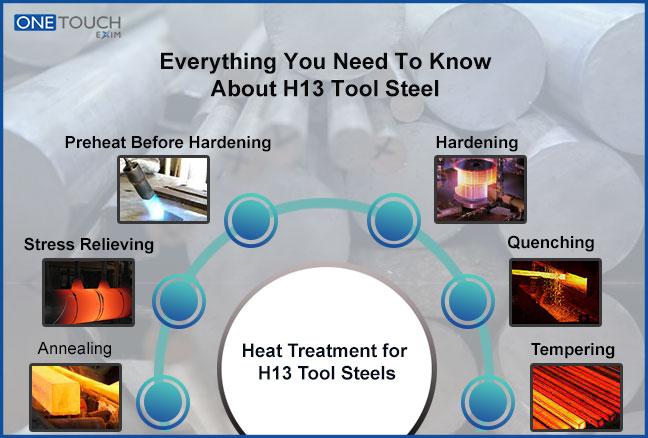H13 tool steel is also known as DIN 1.2344 tool steel. Chromium hot-work tool steels are classified as H-group steels by the AISI classification system. This series of steels starts from H1 to H19. AISI 13H tool steel is a well-known and widely used metal. There are many tools made of steel, but this is one of the most demanded steel tools used in various applications. High-quality materials are used in H13 tool steel, such as silicon, carbon, chromium, manganese, and many more. In this article, we will briefly discuss the H13 metal.
What is H13 Tool Steel – An Overview
AISI H13 is characterized by its good resistance to thermal softening, high hardenability, high strength, and high toughness. It is a kind of hot-work chromium steel that is used in hot-work tooling and cold-work tooling applications. H13 steel is widely used in die casting and plastic molds, hot shear blades, hot forging dies, and aluminum alloy die castings. It is the best option for thermoplastic dies because of its capacity to endure rapid cooling at elevated operating temperatures. It has an excellent combination of fatigue resistance, high temperatures, and excellent wear resistance.
The AISI H13 Tool has better hardening ability and ductility than common alloy steels, and elements such as molybdenum and vanadium are added to achieve the specific composition required for the type of steel. ElectroSlag Remelted (ESR) and Vacuum-Arc-Remelted (VAR) are the variants of this steel.
Advantages of H13 Tool Steel
Now we will discuss the advantages of H13 tool steel. This steel is useful in various applications, and it has many advantages, including:
- It adopts melting processes such as power spraying, furnace refining, vacuum treatment, and vacuum smelting.
- H13 Tool Steel reduces harmful elements such as hydrogen, oxygen, and inclusion in steel.
- It has high toughness, high strength, good wear resistance to thermal softening, machinability, and excellent ductility.
- H13 steel is known for its strong and tough color.
- It has excellent thermal and shock resistance.
Disadvantages of H13 Metal
While there are some advantages to using this metal, there are also some disadvantages, which we discussed below:
- The attainment of the desired property in H13 requires specific and precise heat treatment processes.
- It is extremely expensive compared to the other tool steels.
- It has limited welding ability, and special precautions need to be taken during the welding process to prevent cracking and preserve its properties.
- It is not highly corrosion-resistant, which is a concern in environments in which the tool or die is exposed to corrosive agents.
Application of H13 tool steel heat treatment
Annealing:
H13 steel may be annealed by heating to 1600°F. It soaks one hour per inch of greatest thickness, and the furnace cools at 30 degrees per hour to 900°F. Then the air cools. Proper annealing procedures include packing in a sealed container using a neutral inert material. Resulting in a maximum Brinell hardness of 207. It needs to take suitable precautions to prevent excessive decarburization and carburization.
Hardening:
Preheat at a controlled temperature (between 1300 and 1400°F) in a controlled environment. Astm 13 heats at 1850°F for 1 hour per inch for the largest cross-section. Quench in cool air and cool immediately. When maximum hardness is required, H13 can be oil cooled. However, it is important to note that when oil-cooled, this steel grade is prone to cracking. It also has the same deformative properties as an oil-hardened tool steel.
Forging H13 Tool Steel:
Preheat slowly to 750°C, then increase the temperature to 1050-1100°C. Never forge under 850°C. After forging, it is important to cool H13 slowly. This can be done in a furnace or with vermiculite.
Tempering:
Heat the H13 evenly to the desired temperature and soak for 2 hours per 25mm ruling section. Take it out of the furnace and let it cool in the air. We strongly recommend a second tempering. All the H13 tools should cool to room temperature in between temps. The normal tempering temperature range is 530- 650°C, depending on the tool’s hardness and operating temperature.
Chemical Composition Of H13 Steel
There are many chemical compositions used in H13 tool steel, such as 4.75%-5.50% Chromium, 0.35%-0.42% Carbon, 1.10%-1.75% Molybdenum, 0.80%-1.20% Silicon, 0.30% Phosphorus, 0.30% Sulfur, and 0.20-0.50 manganese. These chemical compositions make this steel a high qualitative steel with excellent corrosion resistance.
Properties of H13 Tool Steel
The properties of H13 Tool Steel prove that the said steel has some unique qualities like strength, hardenability, etc. There are some properties that we have discussed below:
Physical Properties:
The melting point and density of the H13 tool steel are 7.80 g/cm3 at 20°C and 1427 °C, respectively:
Mechanical Properties:
The mechanical properties of the H13 steel tool show the different reactions that vary with heat treatment. This steel records 505 reductions in area and 215 Gpa modulus of elasticity at 20°C. The Poisson value of H13 Tool Steel is 0.27-0.30. The ranges of tensile strength and yield strength are 1000-1380 MPa and 1200-1590 MPa, respectively.
Thermal Properties:
H13 Tool Steel in terms of its thermal properties, 10.4 x 10.6°C expansion, and 20-100°C temperatures. It has a thermal conductivity of 215°C.
Conclusion
We conclude this blog by stating that H13 tool steel is a type of steel. This tool includes many rich materials, which makes it a highly demanded steel and widely used metal. H13 tool steel has incredible strength and good durability and is used in many applications because of its excellent wear resistance.
